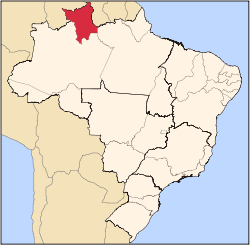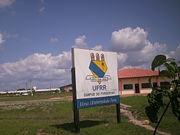Roraima
|
State of Roraima
|
||||||
|---|---|---|---|---|---|---|
|
||||||
 |
||||||
| Capital (and largest city) |
Boa Vista | |||||
| Demonym | Roraimense | |||||
| Government | ||||||
| - | Governor | José de Anchieta Júnior | ||||
| Area | ||||||
| - | Total | 224,298.98 km² (14th) | ||||
| Population | ||||||
| - | 2006 estimate | 403,344 (24th) | ||||
| - | 2005 census | 392,255 | ||||
| - | Density | 1.8/km² (27th) | ||||
| GDP | 2005 estimate | |||||
| - | Total | R$ 3,179,000,000 (27th) | ||||
| - | Per capita | R$ 8,123 (14th) | ||||
| HDI (2005) | 0.750 (medium) (17th) | |||||
| Abbreviation | BR-RR | |||||
| Time zone | BRT (UTC-4) | |||||
| - | Summer (DST) | BRST (UTC-2) | ||||
Roraima (pronounced [ʁoˈrajma] or [ʁoˈrãjma][1]) is the northernmost and least populated state of Brazil, located in the Amazon region. It borders the states of Amazona and Pará, as well as the nations of Venezuela and Guyana.
Contents |
Geography

The climate is tropical with an annual mean temperature of 26°C (78.8°F). Most of the state is located in the Amazon rainforest, with a small strip of savanna to the east. The state is rich in mineral deposits - especially gold, diamonds, cassiterite, bauxite, marble and copper. Many of these deposits are located in indigenous reserves, and illegal mining has resulted in frequent conflicts with the native population, especially that of the Yanomami and the Macuxi and allied groups.
The Monte Roraima National Park is located around one of the highest mountains of Venezuela, a 2,727 m high tepui known as Monte Roraima.
Climate
Except in the higher mountains where the climate is cooler but very wet, Roraima has an equatorial climate. This is a type of tropical climate in which there is no dry season – all months have mean precipitation values of at least 60 mm. It is usually found at latitudes within five degrees of the equator – which are dominated by the Intertropical Convergence Zone. The equatorial climate is denoted Af in the Köppen climate classification. Tropical rainforest is the natural vegetation in equatorial regions.
Vegetation
The Amazon represents over half of the planet's remaining rainforests and comprises the largest and most species-rich tract of tropical rainforest in the world. Wet tropical forests are the most species-rich biome, and tropical forests in the Americas are consistently more species rich than the wet forests in Africa and Asia.[2] As the largest tract of tropical rainforest in the Americas, the Amazonian rainforests have unparalleled biodiversity. More than 1/3 of all species in the world live in the Amazon Rainforest.[3]
History

Since the beginnings of the 16th century, the region now considered the state of Roraima was disputed territory, because of its rich mineral reserves. It was sought by the Spanish, Portuguese, Dutch and English until the beginning of the last century. But in 1943, together with a section from the state of Amazonas, the Federal Government created the territory of Branco River, which became Roraima in 1962. In 1988, Roraima became a state by decision of the National Congress. The name of the state was taken from Monte Roraima, whose name comes from the Pemon words “roroi” (“cyan”) and “ma” (“large”).
Demographics
According to the IBGE of 2007, there were 405,000 people residing in the state. The population density was 1.8 inh./km².
Urbanization: 80.3% (2004); Population growth: 4.6% (1991-2000); Houses: 97,465 (2005).[4]
The last PNAD (National Research for Sample of Domiciles) census revealed the following numbers: 278,000 Pardo (Brown) people (68.8%), 81,000 White people (20.0%), 29,000 Black people (7.4%), 15,000 Asian or Amerindian people (3.8%).[5]
The Brazilian Indian agency, (FUNAI) estimates the state's indigenous population at 30,715.[6] The largest indigenous groups are the Macuxi (16,500)[7] and the better-known Yanomami. (11,700)[8] Much of the state's indigenous population lives in several large, legally recognized indigenous reserves and a number of smaller ones, totalling 46.13% of the land area of the state.[9]
Interesting facts
Vehicles: 74,181 (March/2007); Mobile phones: 148,000 (April/2007); Telephones: 67,000 (April/2007); Cities: 15 (2007).[10]
Economy
The service sector is the largest component of GDP at 87.5%, followed by the industrial sector at 8.7%. Agriculture represents 3.8%, of GDP (2004). Roraima exports: wood 74%, leather 22.6% (2002).
Share of the Brazilian economy: 0.1% (2005).
Education

Portuguese is the official national language, and thus the primary language taught in schools. But English and Spanish are part of the official high school curriculum.
Educational institutions
- Universidade Federal de Roraima (UFRR) (Federal University of Roraima);
- Centro Federal de Educação Tecnológica de Roraima (Cefet-RR);
- Faculdade de Ciências Humanas, Biológicas e da Saúde (FCHBS);
- Faculdade de Teologia de Boa Vista (Fatebov);
- Faculdade Roraimense de Ensino Superior (Fares);
- Faculdades Cathedral - Boa Vista (Cathedral-Boa Vista);
- Faculdade Atual da Amazônia - (FAA)
Infrastructure
International Airport
Boa Vista International Airport was opened on February 19, 1973, and underwent its first big remodeling in 1998. The passenger terminal, runway and apron were all enlarged, and a separate taxiway was built. The airport has the capacity to receive 675,000 passengers a year in total comfort and security.
Highways
- BR-174;
- BR-210;
- BR-431;
- BR-432;
- BR-410;
- RR-171;
- RR-175;
- RR-202;
- RR-203.
Flag
The blue of the flag represents the pure air and the sky of Roraima, the white strip symbolizes peace, and the green to the right represents the forests and fields. The star - symbolizing the state in the national flag of Brazil - is yellow, which symbolizes the mineral resources of the state. The red line in bottom stands for the equator, which cuts through the state. The flag was designed by the artist Mário Barreto, and was adopted by Law No.133 of June 14, 1996.
References
- ↑ In Brazilian Portuguese. The European Portuguese pronunciation is [hoˈɾajmɐ].
- ↑ Turner, I.M. 2001. The ecology of trees in the tropical rain forest. Cambridge University Press, Cambridge. ISBN 0-521-80183-4
- ↑ Amazon Rainforest, Amazon Plants, Amazon River Animals
- ↑ Source: PNAD.
- ↑ (in Portuguese) (PDF)Síntese de Indicadores Sociais 2007. Roraima, Brazil: IBGE. 2007. ISBN 85-240-3919-1. ftp://ftp.ibge.gov.br/Indicadores_Sociais/Sintese_de_Indicadores_Sociais_2007/Tabelas. Retrieved on 2007-07-18.
- ↑ FUNAI
- ↑ http://www.socioambiental.org/pib/epi/verbetinho/comfoto/macuxi.htm
- ↑ http://www.socioambiental.org/pib/epienglish/yanomami/yanomami.shtm.
- ↑ http://www.socioambiental.org/e/nsa/detalhe?id=2669
- ↑ Source: IBGE.
See also
- (English) Brazil
- (Portuguese) Official Website
- (English) Brazilian Tourism Portal
- The similarly spelled Roraimia is also the generic name for the Roraiman Barbtail, a South American bird.
|
||||||||||||||||||||||||||
|
|||||||||||||||||||||||||||||
|
|||||||||||||||||||||||

